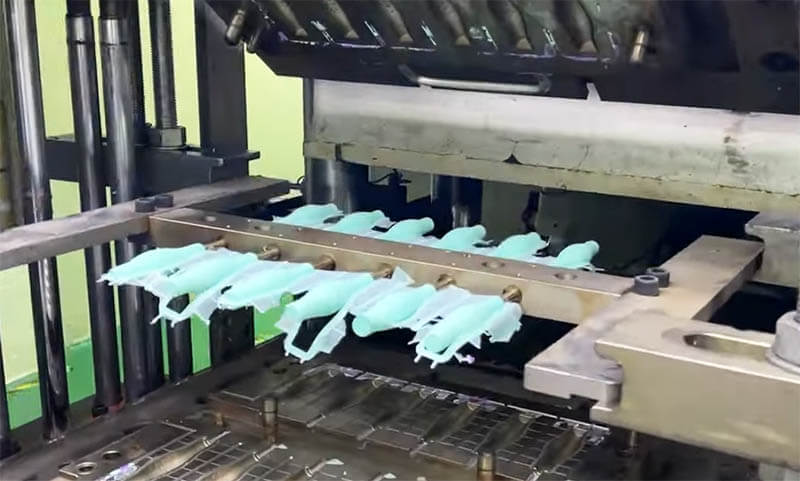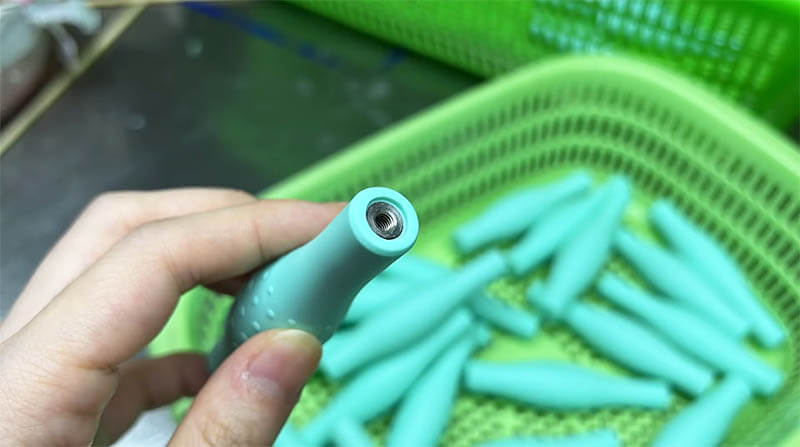What is silicone overmolding?
Silicone Overmolding, also known as Rubber Overmolding or Liquid Silicone Rubber (LSR) Overmolding, is a sequential injection molding technique where multiple components are molded together, one layer atop another. This process is often described as two-shot molding, signifying its two-stage nature.
High-temperature-resistant thermoplastic materials such as PC, PPSU, PA + GF, and PBT are secondary molding materials. On the other hand, the primary overmolding material is commonly silicone (either high-temperature vulcanizing silicone or low-temperature vulcanizing silicone) or liquid silicone rubber (LSR). Compared to assembled or bonded parts, silicone overmolded components exhibit superior quality.
The process generally involves the following steps:
1. Preparation of the substrate: The substrate material, such as plastic or metal, is prepared and placed into the mold.

2. Application of a bonding agent: A bonding agent is sometimes applied to the substrate to promote better adhesion between the substrate and the silicone material.
3. Injection of silicone: The silicone material is heated and injected into the mold, encapsulating the substrate.
 Injection of silicone-Silicone Overmolding
Injection of silicone-Silicone Overmolding4. Curing: The silicone material cures, or solidifies, around the substrate, bonding the two components together.

5. Demolding: The finished product is removed from the mold, and any excess silicone is trimmed away.

Silicone over-molding is a popular choice for manufacturing due to the unique properties of silicone, including its flexibility, durability, and ability to withstand extreme temperatures. This process is used in various industries, such as automotive, electronics, medical, and consumer goods, to create products like seals, gaskets, grips, buttons, and protective cases.
Silicone Overmolding Materials
Liquid Silicone Rubber (LSR): Before overmolding with liquid silicone rubber, a primer is applied to the substrate material. Adhesion will occur where the primer is applied, and no adhesion will occur where it is not. As such, any excess silicone rubber is easier to remove than with self-adhesive silicone rubber.
Overmolding with liquid silicone rubber typically employs a needle or valve-type cold runner. Theoretically, the mold cavity can maintain a complete vacuum, which enhances sealant application. This attribute helps avoid aesthetic defects in the parts and products if gas in the mold cavity cannot be expelled. Most liquid silicone rubber products have a high likelihood of excess silicone rubber during the overmolding process, so it's crucial to maintain a vacuum in the mold cavity and employ a needle valve runner.
The Benefits of Silicone Overmolding
Silicone overmolding offers many benefits, making it an attractive choice for many manufacturers. These include:
Durability and Longevity: Silicone is known for its durability and ability to withstand a wide range of temperatures, from extreme heat to cold, without degrading. This makes it ideal for products that must last long or withstand harsh conditions.
Flexibility: Silicone is highly flexible, making it a great choice for overmolding. It can be molded into complex shapes and geometries and maintains flexibility even after overmolding.
Improved Aesthetics: Silicone overmolding can enhance the visual appeal of a product by adding color, texture, or a soft-touch finish. It can also be used to add branding or other design elements.
Enhanced Grip and Tactile Feel: Silicone provides a comfortable, non-slip grip, making it ideal for products that are held or handled frequently, like tools, sports equipment, or consumer electronics.
Shock Absorption and Vibration Damping: Silicone has excellent shock-absorbing properties, which can protect sensitive components in the event of a drop or impact. It can also dampen vibrations, reducing noise and improving the user experience.
Chemical Resistance: Silicone is resistant to many chemicals, making it suitable for products exposed to oils, solvents, or other harsh substances.
Biocompatibility: Silicone is often used in medical devices because it is hypoallergenic, non-toxic, and can be sterilized. This makes it a good choice for products that come into contact with the body.
Cost-Effective Production: Silicone overmolding can be cost-effective, especially for high-volume production runs. It can reduce assembly time and costs, as the overmolding process can combine multiple components into one part.
These benefits make silicone overmolding a versatile and valuable technique for many products and industries.
Applications of Silicone Overmolding
Due to its versatile properties and advantages, silicone overmolding is widely used across various industries. Here are some typical applications:
1. Medical Devices: The biocompatibility, durability, and resistance to sterilization processes make silicone an excellent choice for overmolding in medical devices. These include surgical instruments, wearable devices, catheters, implants, and seals for medical enclosures.
2. Consumer Electronics: Silicone overmolding creates waterproof seals, protective cases, buttons, and grips for electronics like smartphones, tablets, and remote controls. Its shock absorption property helps protect delicate electronic components.
3. Automotive Components: In the automotive industry, silicone overmolding makes parts like seals, gaskets, buttons, knobs, and protective casings. Its heat resistance is particularly useful in this industry.
4. Kitchenware and Food-Grade Products: Silicone's resistance to heat and its food-safe nature make it perfect for overmolding in kitchenware products such as spatulas, baking molds, collapsible containers, and handles for pots and pans.

5. Baby Products: Given its hypoallergenic, non-toxic properties, silicone overmolding is used in making baby products like pacifiers, bottle nipples, teethers, and spoons.

6. Toys: Silicone's soft, flexible, and durable nature makes it ideal for overmolding toys, providing a soft and safe surface for children to interact with.
7. Personal Care Products: Toothbrushes, razors, and skincare devices often feature silicone overmolding for an improved, comfortable grip.
8. Sporting Goods: Silicone overmolding is used in sporting goods for improved grip and comfort, such as handles for tennis rackets, bicycle grips, and protective gear.
9. Industrial Tools and Equipment: Overmolded handles for tools, vibration-damping components, and protective covers are common in this sector.
These are just a few examples of how silicone overmolding is applied across different industries. The process is valued for its ability to create functional, durable, and aesthetically pleasing products.
Custom Silicone Over-Molding
Mitour Silicone as a professional manufacturer specializing in custom silicone products. We bring extensive expertise and experience in Silicone Over-Molding technologies and silicone over-molded cases. Our capabilities encompass LSR overmolding prototyping, tooling, and processing. We have successfully delivered numerous silicone over-molded components for various specialized programs. Operating under a rigorous quality control system and standard, we ensure the superior performance of our LSR parts and the precision of our manufacturing process. From initial prototyping and design to final manufacturing and assembly, we offer comprehensive solutions for intricate LSR components. Reach out to us today with your specifications! Or learn more about molding process knowledge, such as Silicone Compression Molding or LSR Injection Molding.